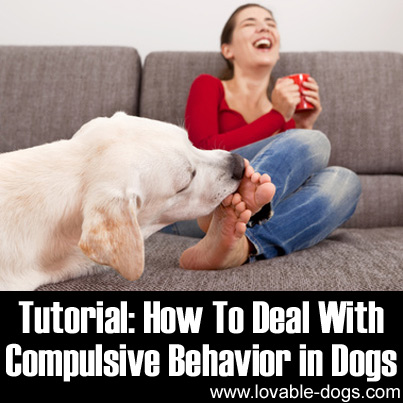
Tutorial: How To Deal With Compulsive Behavior in Dogs – Image To Repin / Share
Image – © iko – Fotolia.com
Disturbed by your dog’s compulsive behavior? If it’s been present for a period of time now, then you should be. A compulsive behavior is one where a dog is performing the same actions over and over again, with no benefit and perhaps detriment. For instance, barking for hours even if there nothing around worth barking about, excessive licking of its self, and chasing its tail in endless circles all the time.
The most common repetitive behaviors which dogs normally exhibit include shadow chasing, spinning, fly biting, flank sucking, licking of objects, checking of hind end, self-mutilation, tail chasing, light chasing, and fence running. [1]
In most cases, the continuous and repetitive exhibition of these behaviors do not serve any purpose. In fact, they are often done out of context. However, researchers believe that it may help in reducing the stress level of dogs – so it is not always harmful.
However the repetitive execution of certain behaviors could eat up a lot of time, and may even result in physical injuries to the dog. In the long run, it can hamper the dog’s ability to perform its functions effectively. Also, it can be annoying which may negatively affect its relationship to its owners.
Research further shows that the occurrence of these behaviors may be triggered by stress, anxiety, changes in physical environment or long period of solitary confinement. At the first stage of the condition, the dog exhibits repetitive behavior once exposed to situations which can increase their level of stress and arousal.
Continuous exposure to stress may enable dogs to incorporate these behaviors into their behavioral repertoire. In the long run, they may elicit the same behaviors even when they are not exposed to stimuli, or even when these triggering factors are removed. At this stage, dogs may no longer be capable of controlling their behaviors. [2]
In diagnosing the condition, owners must be ready to provide a detailed description of the behaviors, their frequency, as well as the duration of occurrence. Furthermore, one must also be aware of the situations where certain behaviors are usually exhibited as this may give clues to help with a solution.
Ok, check out the following page to learn more about solutions to canine compulsive behaviors: http://www.aspca.org/pet-care/virtual-pet-behaviorist/dog-behavior/compulsive-behavior-dogs

